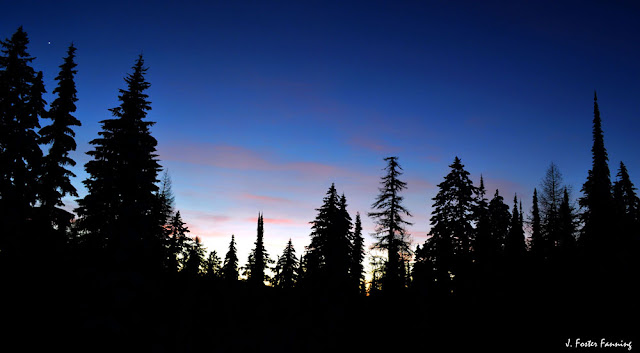While there is a vast plant community within the ecological structure of the varied landscapes of the Ferry County the trees of the area may be considered the primary members of the flora. This is a list of the species of tree found here:
- Douglas fir (pseudotsuga menziesii)
- Ponderosa pine (pinus ponderosa)
- Western larch (larix occidentalis)
- Englemann spruce (picea englemanni)
- Quaking aspen (populus tremuloides)
- Black cottonwood (populus trichocarpa)
- Red alder (alnus rubra)
- Sub alpine fir
- Lodge pole pine
The following are a series of representative images of the flora community of the Ferry County.
 |
| A late October snowfall dusts the yellow needled larch. J. Foster Fanning photography |
Western Larch also known as Mountain Larch is a species of larch native to the mountains of western North America, in western Canada and the United States in eastern Washington, eastern Oregon, northern Idaho and western Montana.This is a large deciduous coniferous tree, which reaches 100’ tall, with a trunk up to 6’ diameter, has it’s needles turn bright yellow in the late autumn and looses all its needles by the early winter months. The largest known Western larch is 153 ft. tall, 22 ft. in diameter, with 34 ft. crown, located at Seeley Lake Boulder / Deer Creek Pass in the Kettle River Range.
Tamarack is the Algonquian Indian name for the species and means "wood used for snowshoes".
 |
| Aspen Grove. J. Foster Fanning photography |
* * *
 |
| A highland marsh frozen and covered under a blanket of snow. J. Foster Fanning photography |
* * *
 |
| Ground fire bypassing Ponderosa Pine. J. Foster Fanning photography |
Also known as Bull Pine, Blackjack Pine, or Western Yellow Pine, is actually ‘Pinus ponderosa’, a very large pine tree native to western North America . It was first described by David Douglas in 1826.
 |
| Balsamroot Sunflowers with Ponderosa Pine. J. Foster Fanning photography. |
Arrowleaf balsamroot (image above) grows in open, dry landscapes, throughout the sagebrush, oakbrush, serviceberry, and ponderosa pine areas. Characteristics include strong drought resistant, good winter-hardiness, semi-shade tolerant, and capable of surviving frequent grazing and trampling. This hardy plant provides good forage for grazing mammals. The flowers are palatable, and all portions of the plant except the coarser stalks are generally consumed.
Some Native Tribes boiled roots, stems, and leaves, for medicinal purposes. Ripe seeds were pounded into flour. The fleshy, edible roots were often eaten raw or boiled.
For more info on the Arrowleaf Balsamroot Sunflower
* * *
 |
| Inner chamber of mature cottonwood. J. Foster Fanning photography |
 |
| Cottonwoods in morning mist. J. Foster Fanning photography |
 |
| Aspen Grove beyond young Ponderosa pine. Background is the mixed fir, larch, pine forest covered slopes of the Kettle River Range. J. Foster Fanning photography |
 |
| Alpine forest of the Kettle Crest in the winter season. J. Foster Fanning photography |
 |
| Alpine fir, lodgepole pine and western larch along the Kettle Crest in winter twilight. J. Foster Fanning photography |

No comments:
Post a Comment